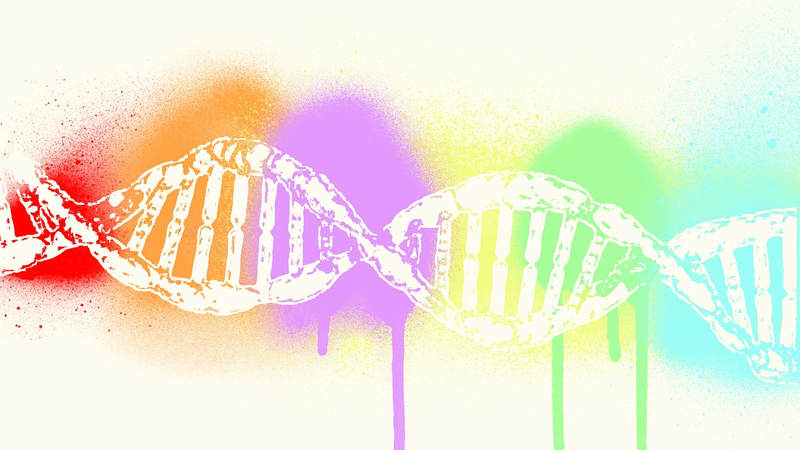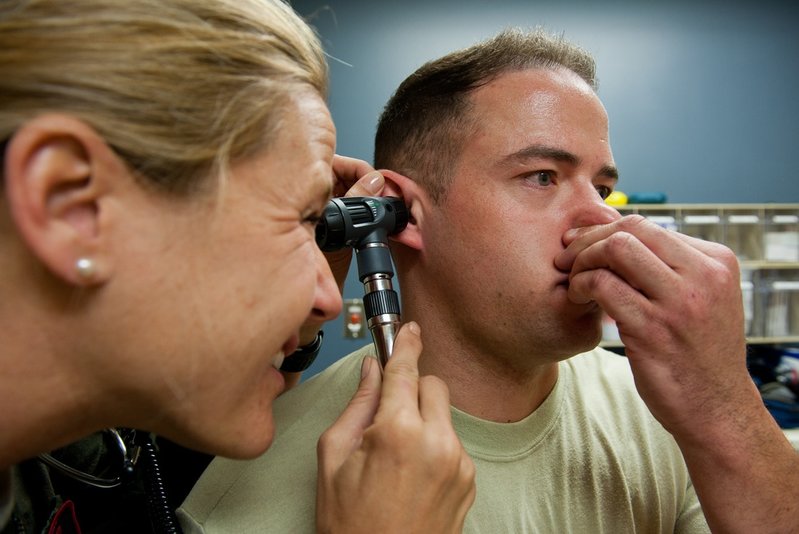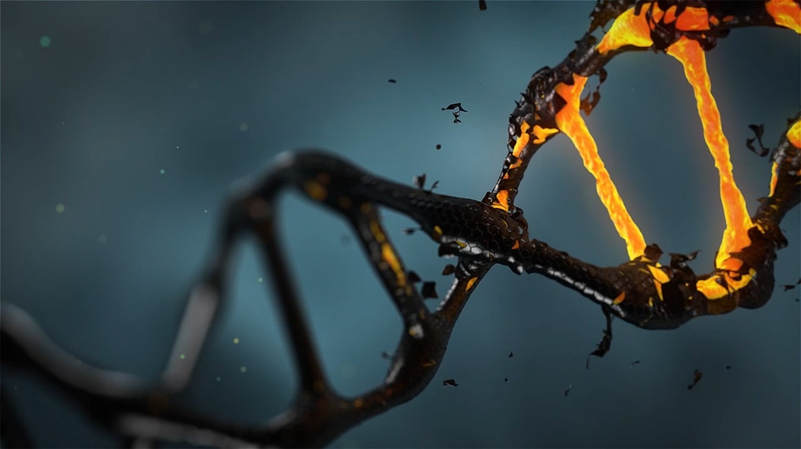DNA Rewind: New Enzyme May Enable More Precise Genome Editing
Composing a deoxyribonucleic acid (DNA) sequence is like typing on a typewriter. Once the key is pressed and the ribbon strikes the paper with ink, the imprint is there to stay, and similarly, when a mistake is made in a DNA sequence, it cannot be deleted in most situations.
However, a new enzyme has been developed that can act as a backspace button and delete mistakes in DNA sequences. The new enzyme, developed by David Liu, an investigator at Howard Hughes Medical Institute, was reported in the scientific journal, Nature, on October 25, 2017. The enzyme, known as the base editor, can precisely change a DNA base pair from an A-T to a G-C, a previously impossible task. This base pair exchange may allow scientists to delete harmful mutations in genomes and, therefore, may be a solution to many genetic diseases.
Encoding every organism’s biological information, DNA is made up of nucleotides, molecules that consist of a phosphate group, a sugar group, and a nitrogen base - adenine (A), thymine (T), guanine (G), or cytosine (C). The nitrogen base on one strand of DNA pairs with a nitrogen base on the other strand, following the base pairing rules: A pairs with T, and G with C. Although the human genome is usually incredibly precise, it is not perfect, and sometimes base mistakes occur, contributing to different diseases, such as sickle cell anemia.
However, a new enzyme has been developed that can act as a backspace button and delete mistakes in DNA sequences. The new enzyme, developed by David Liu, an investigator at Howard Hughes Medical Institute, was reported in the scientific journal, Nature, on October 25, 2017. The enzyme, known as the base editor, can precisely change a DNA base pair from an A-T to a G-C, a previously impossible task. This base pair exchange may allow scientists to delete harmful mutations in genomes and, therefore, may be a solution to many genetic diseases.
Encoding every organism’s biological information, DNA is made up of nucleotides, molecules that consist of a phosphate group, a sugar group, and a nitrogen base - adenine (A), thymine (T), guanine (G), or cytosine (C). The nitrogen base on one strand of DNA pairs with a nitrogen base on the other strand, following the base pairing rules: A pairs with T, and G with C. Although the human genome is usually incredibly precise, it is not perfect, and sometimes base mistakes occur, contributing to different diseases, such as sickle cell anemia.
Image Source: jack0m
Different gene editing tools have been used in attempts to fix DNA mutations. For example, CRISPR, an immune defense system originally discovered in bacteria, has led to the development of the CRISPR-Cas9 technology, a system in which a cell’s genome is cut at specific regions, removed, and replaced with a new gene sequence.
While this technology has made great advances in the gene editing field, it targets DNA “chunks” rather than the individual base pairs. CRISPR-Cas9 acts like a pair of scissors: cutting blocks of DNA at a time. However, the newly developed base editor may be the solution to this problem. By exchanging an A-T base pair for a G-C base pair, the base editor can perform detailed and precise gene edits that CRISPR cannot.
The Liu lab took advantage of evolution to create the base editor enzyme. Initially, Liu used TadA, an enzyme that can switch out an adenine base for inosine (a base that cells treat as guanine) in RNA. Researchers used TadA as a starting point because it was able to perform a base switch, but the task at hand was getting the enzyme to perform the switch in DNA. TadA was placed in bacteria colonies exposed to harsh environments, and in order to survive these harsh conditions, the bacteria evolved the ability to switch out the adenine base for inosine in DNA, rather than strictly in ribonucleic acid (RNA), which allowed the bacteria to freely fix mutations in their own genome.
Adjustments were made to the enzyme to make it more efficient, such as attaching the base editor to another enzyme that allowed it to scan and cut at the exact location on the DNA strand and its opposing strand in the double helix. This prompted the cell to insert the correct base pair to match the new one, and since the enzyme could switch an adenine for an inosine, this successfully exchanged the A-T base pair with a G-C base pair.
Currently, advances are being made to the base editor enzyme to enhance its efficiency. For example, one version of the enzyme, called ABE7.10, can perform this precise base pair switch in human genomes. Hemochromatosis is a genetic iron storage disease that involves a G-to-A base mutation, and in Liu’s study, ABE7.10 was able to reverse the mutation in cells taken from affected patients, which demonstrates the promising possibilities the base editor has for treating the genetic disease.
Many other human diseases can result from mutations involving the switch of a G-C base pair to an A-T base pair, and the base editor may be solution to this issue. While the base editor is still in the early stages of tweaking, this new backspace button has promising implications for the future of genome editing and disease treatment.
While this technology has made great advances in the gene editing field, it targets DNA “chunks” rather than the individual base pairs. CRISPR-Cas9 acts like a pair of scissors: cutting blocks of DNA at a time. However, the newly developed base editor may be the solution to this problem. By exchanging an A-T base pair for a G-C base pair, the base editor can perform detailed and precise gene edits that CRISPR cannot.
The Liu lab took advantage of evolution to create the base editor enzyme. Initially, Liu used TadA, an enzyme that can switch out an adenine base for inosine (a base that cells treat as guanine) in RNA. Researchers used TadA as a starting point because it was able to perform a base switch, but the task at hand was getting the enzyme to perform the switch in DNA. TadA was placed in bacteria colonies exposed to harsh environments, and in order to survive these harsh conditions, the bacteria evolved the ability to switch out the adenine base for inosine in DNA, rather than strictly in ribonucleic acid (RNA), which allowed the bacteria to freely fix mutations in their own genome.
Adjustments were made to the enzyme to make it more efficient, such as attaching the base editor to another enzyme that allowed it to scan and cut at the exact location on the DNA strand and its opposing strand in the double helix. This prompted the cell to insert the correct base pair to match the new one, and since the enzyme could switch an adenine for an inosine, this successfully exchanged the A-T base pair with a G-C base pair.
Currently, advances are being made to the base editor enzyme to enhance its efficiency. For example, one version of the enzyme, called ABE7.10, can perform this precise base pair switch in human genomes. Hemochromatosis is a genetic iron storage disease that involves a G-to-A base mutation, and in Liu’s study, ABE7.10 was able to reverse the mutation in cells taken from affected patients, which demonstrates the promising possibilities the base editor has for treating the genetic disease.
Many other human diseases can result from mutations involving the switch of a G-C base pair to an A-T base pair, and the base editor may be solution to this issue. While the base editor is still in the early stages of tweaking, this new backspace button has promising implications for the future of genome editing and disease treatment.
Featured Image Source: gagnonm1993
RELATED ARTICLES
|
Vertical Divider
|
Vertical Divider
|
Vertical Divider
|





